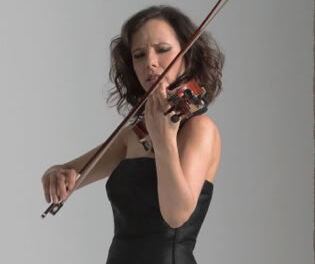The community room of the Albert Carlton Library in Cashiers was the venue for this stunning program sponsored by the Highand Cashiers Chamber Music Festival. The Festival is in its 32nd season and is directed by William Ransom. The concerts move chiefly between Highlands and Cashiers and are held in relatively small, congenial spaces such as this one, affording every listener close proximity to the players. One can not only enjoy the world class performances, but observe in some detail the beaded brows, the working musculatures, the fierce concentration, and all the other mechanics required to coax beautiful sounds out of boxes with strings. The members of the renowned Eroica Trio (violinist Sara Parkins, cellist Sara Sant’Ambrogio, and pianist Erika Nickrenz) were joined by violist Miles Hoffman and a 21-year-old violinist Margeaux Maloney who is a rising senior at The Julliard School. This concert was underwritten in part by Judy and Louis Freeman.
I haven’t heard the Eroica Trio in several years, and remembered them as consummate musicians with an aggressive performance style, huge gestures, and gorgeous clothes. The ensemble certainly seems to have mellowed a bit. Gone are what I had viewed as excessive movements I’d found distracting in previous performances. What I witnessed was a superbly poised, musically nimble and savvy group of beautiful women who seemed to have ditched the theatrics and simply played the heck out of each and every score. The gorgeous clothes are still there!
The opener was a Sonata in B minor for Trio by Flemish composer Jean Baptiste Loeillet de Gant (from Ghent, 1680-1722), thought to be the second work from Book 5. Though the original instrumentation of the work is uncertain (as it was common to interchange instruments based on what one may have had on hand), it worked well on the instruments of this trio, even the piano which was a modern substitute for the harpsichord. Typical of a sonata da chiesa, or “church sonata,” its four-movement format consisted of alternating slow and fast movements, the latter in imitative style. In the first two movements the cello initiated each phrase for the violin to follow. The simple, cantabile lines of the slow movements were exquisitely played and the expressive dissonances created by chains of suspensions were so beautifully interpreted they created some of the most moving music of the entire concert. The fast movements with their scintillating passagework in rapid-fire sixteenth notes were deftly executed and simply thrilling, with the piano-as-continuo providing the driving rhythmic and harmonic “track.” There was a mishap when a violin string broke during the second movement, but that gave rise to a series of great stories of other stage disasters shared by the ensemble (and Ransom, who happened to be page turning) while the string was replaced. Fabulous!
Hoffman and Maloney joined the Trio just before intermission for Robert Schumann’s Piano Quintet in E-flat, Op. 44 (1842). This work of 1842 is an enormously appealing work, and of a size and scope that warrants its frequent use as a program closer. It is a work of superlatives — Schumann composed it, the first of a new genre, at lightning speed, and Mendelssohn stepped in and sight-read the piano part after Clara Schumann, scheduled to play it, fell ill. Though the piece is symphonic in conception, it still retains many moments of transparency, allowing the intimate conversations among the instruments to be heard. The first movement Allegro brilliante showcased the precision of the ensemble and their deep connection to its musical material, and the balance was just right, with the busy piano figurations never overshadowing the whole. The interpretation of the funereal second movement, In modo d’una Marcia, was also deeply satisfying. Each player dug into the mournful qualities of the principal, halting melody and somber dotted rhythms, relieved only by contrasting sections of either more cantabile melodies or agitato outbursts. All sorrow was abandoned in the following scherzo, an etude of dizzying scalar figures that whizzed up and down, and the final Allegro ma non troppo which built to a climax of contrapuntal episodes. The communication among the players and to the audience was superb and brought the house to its feet.
The standalone work after intermission was the massive Dvořák Piano Quartet in E-flat, Op. 87. Again, Hoffman joined the Eroica Trio for this work, and through him we heard the ghost of Dvořák, who also played the viola. Dvořák composed two piano quartets — this one was written in six weeks in 1889. Dvořák, of course, is famous for his advocacy of Bohemian music, and national characteristics appear over and over in this work. He must have had an orchestral sound in his head at the time of composition, as the sound ideal is big and bigger. The ensemble’s approach to the work centered around the big moments, all played without restraint or over refinement. The result was a raw thrill, even astonishing at times as new sound effects — the soft tremolos toward the end of movement one, for example — were generated. The second movement Lento vacillated between introverted and extroverted sections and each was strongly etched. The ethnic quality of the third movement Allegro moderato, grazioso was unmistakable, with the surprise simulation of the cimbalon in the high, tinkling piano part one of the most original moments of the entire piece. The finale predictably required lots of full-on playing through its many quirky modulatory turns and huge climaxes, and the ensemble delivered in spades, again bringing this audience to its feet.











